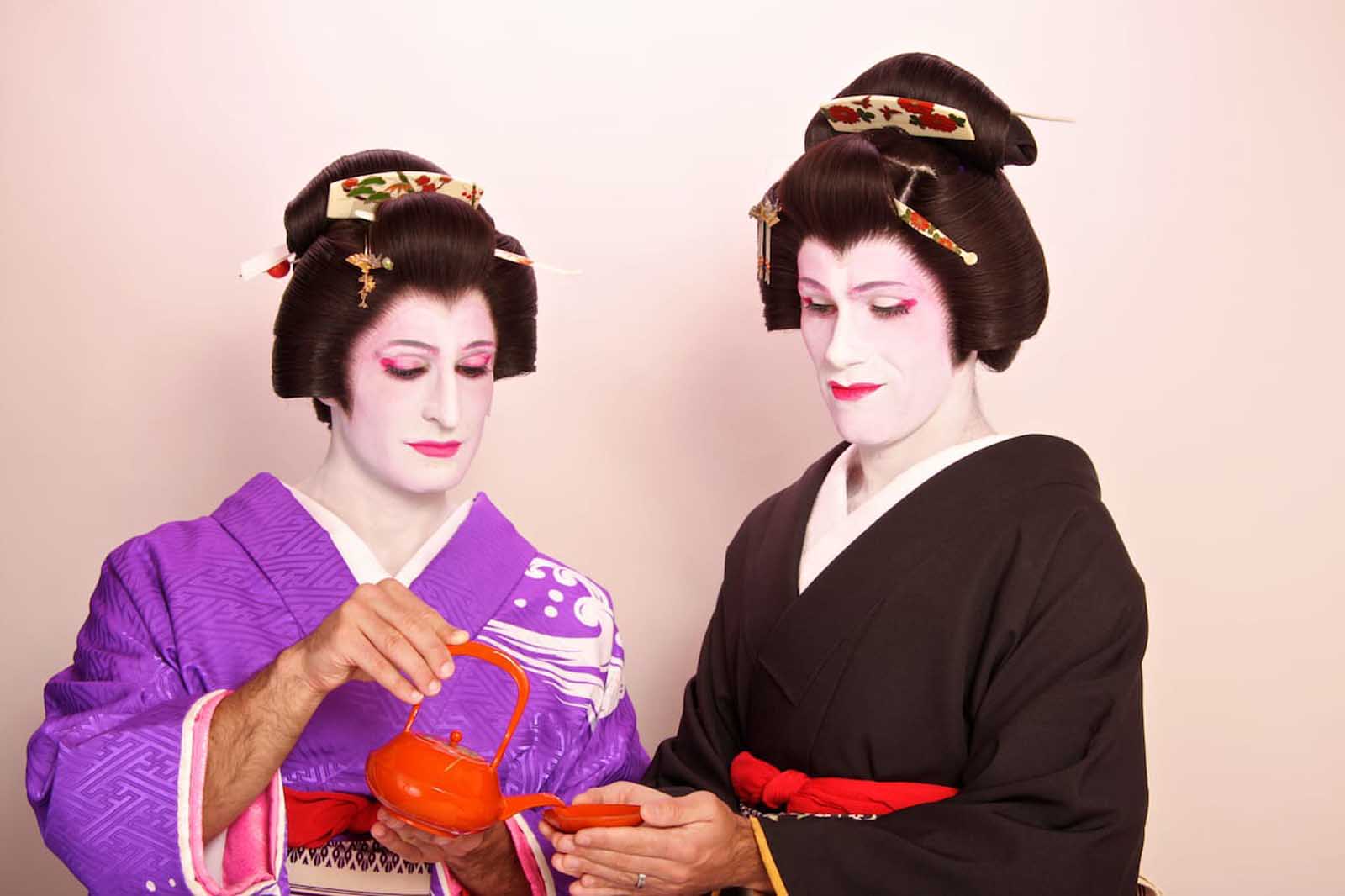Summary
“As Sayuri was standing beneath the Cherry tree, speaking to the one man she loved but could not have, a sprinkle of delicate pale pink petals fell upon them like snow…” At this point, Sebastien GRABBED the remote control, interrupting the most beautiful moment of Memoirs of a Geisha and in his French accent declared to Stefan: “One day, we too, will become a male geisha!”
About Taikomochi – The Male Geisha Culture in Japan

The term geisha combines gei (art) and sha (person), translating to art person. Historically, geisha were male entertainers skilled in classical music, dance, and games, serving as advisors to daimyo (feudal lords) since the 1200s. They were also renowned tea connoisseurs and storytellers.
The first female geisha appeared in 1751 and quickly became popular, outnumbering their male counterparts. Today, Japan has only 5 known male geisha: 4 in Tokyo and 1 in Kyoto, with an additional 2 if you count the Nomadic Geisha.
The Studio Geisha Cafe
Fast forward to our second visit to Japan, where we finally dressed as male geisha in Tokyo.
“Half our customers are Japanese men, mainly straight men, wanting a unique transformation,” says Michiru, the owner of the Studio Geisha Cafe.
Michiru, a former model and actress, opened the cafe with her husband to allow people to experience their dreams. She typically assists Japanese men in transformation but was excited to welcome her first foreign male geisha.
The cafe, located in Morishita, a suburb of Tokyo, allows individuals to embody the geisha or samurai experience, immersing them in traditional Japanese culture.
Who Dresses Up as a Geisha?
People mainly participate for a keepsake photo, while others, like honeymooners, opt for traditional Japanese wedding attire.
Michiru does not offer outfit rentals; instead, she emphasizes the artistry behind the male geisha transformation, rejecting requests that trivialize the experience.
For instance, she declined a proposal from a Japanese man wanting to dress as a geisha with a moustache for a comedic TV segment.
Our Geisha Transformation Experience
The experience served as an education about a geisha’s daily life, infusing every stage of the transformation with cultural significance—right from wig styling to the application of vivid white makeup.
Michiru guided us through cultural nuances, such as the geisha’s characteristic poses (which avoid a toothy smile) and the subtle hints of red from undergarments (intended to intrigue).
The intricate details involved in becoming a geisha become more evident once you undergo the transformation process.
Watch Our Time-Lapse Video of the Male Geisha Makeover in Tokyo:
The transformation, spanning about three hours including the photoshoot, began with us changing into the white hada-juban undergarment and geisha tabi socks.
The tabi socks separate the toes: one space for the big toe and another for the rest, ensuring comfort in the high wooden okobo shoes that keep kimonos elevated off the ground. Planning a visit to Japan? Explore the Top 10 Things to Do in Kyoto, where geisha culture thrives.
The White Shironuri Makeup
The geisha’s iconic white shironuri makeup consists of a thick paste, traditionally used to illuminate youthful beauty in dimly-lit rooms pre-electricity. For budget travel tips, check out Travel to Tokyo on a Budget.
To prepare, several layers of makeup concealed our beard shadows, requiring eyebrow removal with special wax and painting new ones. This transformative step was quite unexpected.
With the absence of our eyebrows, our features shifted dramatically, revealing a new, more feminine impression.
Fitting the Geisha Wigs
After applying the makeup, it was time to fit the wigs.
The geisha wigs are typically based on the shimada hairstyle, popular among merchant wives during the Edo period (1603-1868), characterized by hair gathered at the crown with a portion styled outward.
Michiru’s husband, a wig specialist, dedicated considerable time fitting our wigs, ensuring a perfect size and style for each of us.
Kimonos, Lights, Action!
After our beautiful kimonos were in place, we practiced our poses in front of a full-length mirror.
The intense makeup made our reflections almost unrecognizable.
As the photoshoot unfolded, Michiru, initially reserved, became more enthusiastic, eagerly adjusting our kimonos and exclaiming, “Gorgeous! Gorgeous!”
Ultimately, this memorable experience offered fascinating insights into an elusive aspect of Japanese culture.
More About Taikomochi
The term taikomochi, or “male geisha,” unveils an intriguing yet underrepresented aspect of Japanese entertainment. Historically, taikomochi means “drum carrier,” referencing their role as musicians at Edo period festivals. Before the rise of female geishas, these male entertainers were influential in the entertainment sector.
Like female geishas, taikomochi entertained guests through music, dance, and engaging conversation, aiming to enliven events with humor and stories. However, with the growing popularity of female geishas, the demand for taikomochi has significantly declined.
Today, only a few taikomochi remain active, mostly in Tokyo, providing a rare glimpse into traditional Japanese culture. While both geishas and taikomochi entertain, their methods differ: geishas focus on traditional arts like dance and music, while taikomochi engage audiences with lighthearted storytelling.
If you wish to experience your own transformation into a geisha, consider Michiru’s Studio Geisha Cafe for an authentic experience.





